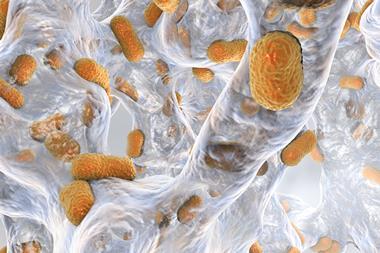Andy Extance talks to the researchers innovating across different drug classes in the hunt to develop new treatments that are safe and effective enough to satisfy regulators
When Daniel Pevear first got into anti-microbial drug discovery in the late 1980s ‘people believed that we had so many great antibiotics that the war against pathogenic bacteria may have been won’, he says. He was working in the antibacterial research team of the now-defunct pharma company Sterling Winthrop in Albany, US. Or at least he was until the team was suddenly completely reassigned to working on antiviral drugs. ‘They just decided that there was nothing to discover,’ Pevear says.
Then, as now, drugs based on the four-atom amide ring known as a β-lactam held pride of place in the antibacterial pharmacopeia. The most famous antibiotic, penicillin – actually benzylpenicillin or penicillin G – was accompanied by fellow penams such as amoxicillin and ampicillin. All the penams have a β-lactam fused to a five-membered thiazolidine ring. Some could even fight the tough Gram-negative bacteria, named after the result that they give in a staining test. Bacteria that come up negative have two layers around their cell that drugs need to get through, rather than just one. By the 1980s certain β-lactams, especially cephalosporins like ceftriaxone and cefotaxime, where the non-β-lactam ring is a six-membered dihydrothiazine, could also do just that. So too could non-β-lactam quinolone and fluoroquinolone antibiotics like ciprofloxacin.
By the 1990s, the confident antibiotic attitude had reversed, as bacteria showed that they could quickly evolve to endure such drugs. Most notably methicillin-resistant Staphylococcus aureus (MRSA) had become increasingly widespread. Other bacteria developed β-lactamase enzymes that degrade β-lactam-based antibiotic drugs. Pevear, who today is senior vice president of biology and grants development at VenatoRx Pharmaceuticals, explains that MRSA led to the first oxazolidinone antibiotic, linezolid, and the lipopeptide antibiotic daptomycin. Better hospital practices also helped prevent transmission, he says. However, despite these achievements, the antibiotic research lull continues, according to Pevear.
In 2010, Pevear co-founded VenatoRx with grant support from the US National Institutes of Health (NIH) for up to $4.3 million (£3.4 million) to try to restore β-lactams’ power, by developing drugs that can inhibit β-lactamase enzymes. That involved ‘trying to look into the crystal ball’ of exactly how β-lactamases would evolve over the next decade and beyond, Pevear says. An increased global population, travelling internationally, combined with limited oversight of how antibiotics are used in people and animals have all driven new resistance mechanisms, he adds. ‘We can watch in real time these superbugs evolving. Frankly it’s quite frightening how quickly they can become a dominant organism.’
Though there is still limited interest from large pharmaceutical companies in developing antibiotics, a raft of smaller ones like VenatoRx remains. They enable researchers to tackle the scientific challenge of battling antimicrobial resistance. The greatest prize of all is to discover a wholly new structural class of antibiotic that bacteria have never encountered, and therefore are unprepared to resist. Yet finding such substances and then proving to regulators that they are both effective and safe is massively difficult. So, many companies are also seeking ways to keep the older antibiotic structural classes effective and address their shortcomings.
Chemical warfare
A classic structure in pharmaceutical chemistry, the β-lactam’s shape is nearly identical to a key feature in how molecules recognise each other to link up and form bacteria’s cell walls. Specifically, the β-lactam looks like a pair of alanine amino acids in peptidoglycan molecules that another key cell wall component, penicillin binding proteins (PBPs), target. The β-lactam is highly strained, and usually antibiotic drugs including it have structures designed to withdraw electrons from its carbonyl group, priming the β-lactam to irreversibly react with PBPs. That stops the bacteria growing, then kills them by letting their cell interiors pour out. Because bacterial cell walls are different to those in human cells, drugs containing β-lactams usually safely target bacteria without harming us.
Today, there are nearly 8000 known unique β-lactamases reported
But bacteria reproduce quickly, deftly evolving ways around such drugs, such as β-lactamase enzymes that open β-lactam rings before they attach to bacteria’s cell walls. The first β-lactamase was seen in Escherichia coli even before penicillin came to market. Today, there are nearly 8000 known unique β-lactamases reported, notes Pevear. Such enzymes are the main resistance mechanism in Gram-negative bacteria, which have also evolved pumps that remove drugs from their systems before they can act. Methicillin came to market in 1959 because it is more resistant to β-lactamases than penicillin. Yet around a year later MRSA appeared, which has an extra gene that produces an alternative PBP that sticks less well to β-lactams. This is a more important resistance mechanism in Gram-positive bacteria than β-lactamases.
Today, in many countries two cephalosporins are available that overcome MRSA’s slippery mutations. One of them, ceftobiprole, was developed by Basilea, a Swiss company spun out of pharma giant Roche. Its structure is intentionally designed to bind tightly to the mutant PBP, explains Laurenz Kellenberger, the company’s chief scientific officer. It has a long but rigid sidechain containing an amino group that gives it high affinity to mutant PBP. Meanwhile, the sidechain on the opposite side of the molecule might help provide stability against β-lactamases, Kellenberger adds.
Even with its elegant-sounding biochemical properties, ceftobiprole’s route to market has been mazy, illustrating the challenges of drug discovery in general and antibiotics specifically. It started on its journey at Swiss pharma giant Roche, which decided to exit anti-infectives research and development in 2000. Roche founded Basilea to continue that research, transferring across its anti-infective portfolio, including ceftobiprole, and the researchers working on it. Basilea then partnered with US drug giant Johnson & Johnson (J&J) to run the clinical trials needed to bring ceftobiprole to market. A few countries approved ceftobiprole in 2008, but then the European Medicines Agency (EMA) and the US Food and Drug Administration (FDA) saw issues in how J&J ran the trials and declined to approve it. Consequently, J&J withdrew it from the initial markets in 2010 and returned the global rights to Basilea.
‘There was no question about the efficacy or safety,’ Kellenberger stresses. Basilea therefore submitted its evidence to the EMA, gaining approval in 2013 for hospital- and community-acquired pneumonia. Ceftobiprole is now approved for use in 35 countries and used in about 20. But the FDA still wouldn’t accept the original data. To finally bring ceftobiprole to the US, Basilea has now conducted a new phase 3 clinical trial, and is ready to seek FDA approval again in late 2023 for skin and bloodstream infections. That’s welcome because MRSA is probably the best known antibiotic-resistant bacterium. However, β-lactamases pose a much more intricate antibiotic resistance problem for scientists to address.
Losing inhibition
To meet the initial β-lactamase challenge, researchers sought new types of drugs that would inhibit them. In 1976, scientists found that the Gram-positive bacterium Streptomyces clavuligerus supplied some good options. Among them was clavulanic acid, which would become the first β-lactamase inhibitor available for clinical use. It occupies the sites in β-lactamases that normally break antibiotics down, stopping the enzymes from working. Today, pills of the widely used β-lactam antibiotic amoxicillin normally also contain clavulanic acid, which is known as a β-lactam/β-lactamase inhibitor (BL/BLI) combination.
The respite from resistant microbes provided by early β-lactamase inhibitors didn’t last. Today, scientists group β-lactamases into four classes, labelled A–D. Clavulanic acid only inhibits some class A enzymes. Classes A, C and D use a serine amino acid to break down β-lactams. The class B enzymes, known as metallo-β-lactamases, break down β-lactams using zinc atoms. One recent β-lactamase inhibitor is avibactam, which the FDA approved for clinical use in 2015. It’s prescribed in a BL/BLI combination with the cephalosporin ceftazidime, known together as CAZ-AVI, or Avycaz. Avibactam itself is a diazabicyclooctanone (DBO) rather than a β-lactam, but only inhibits serine β-lactamases from classes A and C.
Kamal Hamed, chief medical officer of US biopharma company Spero Therapeutics, highlights a particular threat from Enterobacterales Gram-negative pathogens that produce class C AmpC β-lactamases. These enable resistance to cephalosporins, penicillins and some BL/BLI combinations. Yet hope comes from other useful substances produced by S. clavuligerus, namely the olivanic acids. These are closely related to the penam structures of penicillin and related β-lactams. They substitute the thiazolidine’s sulfur atom for a carbon atom and have an extra double bond between two carbon atoms, and so are called carbapenems. While the olivanic acids are unstable and can’t get into bacterial cells, they inspired a class of carbapenem β-lactam drugs that were more resistant to β-lactamases. The US Food and Drug Administration (FDA) approved imipenem, the first clinically used carbapenem, for use in 1985.
Today, carbapenems are the antibiotics of choice for treating infections caused by gram-negative Enterobacterales producing AmpC β-lactamases, explains Hamed. However, all marketed carbapenems must currently be injected or infused – they cannot be swallowed as pills. Spero is therefore developing a β-lactam carbapenem prodrug called tebipenem pivoxil hydrobromide that can be taken orally as a pill. Soon after ingestion, tebipenem pivoxil breaks down to the active drug, tebipenem. If approved, the fact it’s a pill could prevent patients with otherwise drug-resistant infections needing to come into hospital, Hamed explains, or let them leave earlier.
Like ceftobiprole, tebipenem pivoxyl is also battling its way through clinical trials. It is already approved in Japan in fine granule form, but for use in children only. Spero’s product is a higher dose tablet for use in adults with complicated urinary tract infections, Hamed says. The FDA has agreed to the conduct of a single ‘pivotal’ phase 3 clinical trial, rather than the usual two. However, the FDA declined to approve the drug following Spero Therapeutics’ first such phase 3 trial, choosing to exclude some patients from Spero’s analysis, and therefore saying that there wasn’t enough positive data to approve the drug.
With the median cost of running a pivotal clinical trial being at least $48 million, Spero therefore sought a partner company. GSK stepped in with a $9m investment, and paid $66 million for rights to market the drug. Spero’s chief executive Sath Shukla says that these figures indicate that antibiotics that offer significant improvements can pay off. He highlights that GSK says that the drug could be on the market by 2026, and earn significant revenue, with milestones due to Spero up to and beyond $1 billion sales. Yet further treatments are still needed, as bacteria have already developed resistance to carbapenems.
A great pathogen threat
Carbapenem-resistant Acinetobacterbaumannii (Crab) top the World Health Organization’s list of bacterial pathogens that pose the greatest threat to human health. Crab primarily have Class D β-lactamases, and cause high mortality rates because there are sometimes no safe and effective treatment options. John O’Donnell, vice president and head of research at Innoviva Specialty Therapeutics in Massachusetts, US, calls this ‘alarming’.
Innoviva therefore developed sulbactam–durlobactam, a BL/BLI combination to treat Crab infections. Durlobactam is a DBO β-lactamase inhibitor like avibactam but spans classes A, C and D, thanks to a more reactive structure and improved enzyme binding. O’Donnell notes that this does create challenges in developing formulations that remain stable when reconstituted in water over the course of a three-hour infusion. Sulbactam itself is a class A β-lactamase inhibitor but can kill bacteria on its own and has been a drug of choice for Acinetobacter. Its effectiveness has been eroded due to the emergence of class D β-lactamases, says O’Donnell, but durlobactam restores that. The FDA approved the sulbactam–durlobactam combination under the trade name Xacduro in May 2023 to treat hospital-acquired and ventilator-associated pneumonia caused by Acinetobacter.
For Xacduro, the key challenge of getting through clinical trials came because there was no effective alternative treatment to compare against, O’Donnell explains. The company used the current standard treatment, which is colistin, a last-resort polymyxin antibiotic, whose kidney-damaging side-effects are problematic.
Have physicians reach for the right drug from the beginning, and you’re clearing the pathogen from your patient
Another challenge companies have faced bringing new antibiotics to market is that doctors commonly hold newly approved antibiotics in reserve, to slow down bacterial resistance emerging. That means that the companies don’t receive any money for the product that they have spent so much time and money developing (see Who will pay for new antibiotics?). O’Donnell suggests that the inevitability of resistance to any antibiotic emerging could be added to the Benjamin Franklin quote ‘Nothing is certain except death and taxes.’
‘Unfortunately, bacteria have the capacity to assimilate genetic material, resulting in the transmission of these resistant determinants across a number of bacterial pathogens,’ O’Donnell says. Innoviva therefore encourages a ‘precision-based pathogen-targeted approach’. This involves identifying drug-resistant Acinetobacter infections quickly and treating them with Xacduro from the outset. That’s better than using ineffective treatments and risking the development of further resistance, lengthy hospital stays, and even death, O’Donnell comments. ‘Have physicians reach for the right drug from the beginning, and you’re clearing the pathogen from your patient,’ he says. ‘And so you have a very effective agent that’s going to last for many, many years to come.’
Subtle strategies
Whereas durlobactam inhibits class A, C and D β-lactamases, when Pevear and his VenatoRx colleagues looked into their crystal ball in 2010, they decided to develop an inhibitor that would work with all subclasses. They realised that increasing use of carbapenems would drive expansion of β-lactamases targeting them, often class B metallo-β-lactamases. That prediction appears to have come true, as a paper published in May 2023 shows. That reported that as of 2019 metallo-β-lactamases are now the dominant resistance mechanism globally in strains of Enterobacteriale s resistant to the carbapenem meropenem.
The lead compound that Pevear and his colleagues are developing is a boronic-acid-containing β-lactamase inhibitor called taniborbactam. VenatoRx applied to the FDA to approve the injectable combination of β-lactam cephalosporin cefepime with taniborbactam in August 2023, hoping for approval in the first half of 2024. In 2024 the company also hopes to start phase 3 clinical trials for a combination of oral cephalosporin ceftibuten and a structurally slightly different boronic-acid β-lactamase inhibitor ledaborbactam, to be formulated in pill form for use outside hospitals. The intention is that the different BLIs will slow down how quickly bacteria become cross-resistant, Pevear explains.
Meanwhile, MicuRx, a China-US biopharma company, is developing improved versions of current drugs of last resort, the oxazolidinones and polymyxins. While some bacteria have developed resistance to the best-established oxazolidinone, linezolid, that’s not why MicuRx is working on them, according to Wen Wang, head of the company’s biology department. Instead, it’s trying to tackle side effects. Linezolid works by inhibiting bacterial protein synthesis, by binding to their ribosomes. However, it also inhibits the human enzyme monoamine oxidase, which degrades neurotransmitters like serotonin and norepinephrine. That can cause the neurotransmitters to build up and trigger ‘serotonin syndrome’ in patients taking antidepressants, potentially causing life-threatening shock and hyperthermia. Linezolid also suppresses our bone marrow from making red blood cells.
MicuRx is developing an oxazolidinone called contezolid and its prodrug form called contezolid acefosamil. Tests including a phase 3 trial in China and a phase 2 trial in the US so far suggest it is safer on the blood cell front. Laboratory data also show it causes fewer serotonin-related side effects and that resistance to contezolid should emerge more slowly than with linezolid.
With its compound MRX-8, MicuRx is taking a similar toxicity reduction strategy to polymyxins like colistin. As circular peptide molecules with fatty acid side chains, scientists think that polymyxins work by sliding into bacterial cell walls, punching holes and disintegrating them. However, the fatty acid tail is considered to be responsible for kidney toxicity. Wang calls MRX-8 a soft drug, by which she means that our bodies break it down. Specifically, the fatty acid tail is attached via an ester bond that hydrolyses once a patient has taken it. ‘We have animal data with preliminary biomarkers showing MRX-8 having less nephrotoxicity than polymyxin B,’ Wang says. MRX-8 is currently in phase 1 trials in people.
As Spero Therapeutics chief executive officer Sath Shukla puts it, ‘polymyxins currently kill bugs but they also kill kidney cells’. His company is therefore also developing a polymyxin with lower nephrotoxicity, codenamed SPR206, and is hoping that at the end of 2023 it will be able to apply to run a phase 2 clinical trial for it. Spero is also developing the hardest-to-attain but most valuable kind of new antibiotic: a wholly new class.
Where are the new antibiotic classes?
SPR720 is an aminobenzimidazole, which has a novel mechanism, explains Hamed. It targets DNA gyrase, which is involved in unwinding bacterial DNA as it replicates. Aminocoumarin and fluoroquinolone antibiotics already inhibit this enzyme, but SPR720 targets a unique site. ‘There’s no cross resistance with any other existing class of antibiotics,’ Hamed says. Spero is current enrolling patients in a phase 2 clinical trial for SPR 720, with the first data due in 2024.
Rather than immediately apply SPR720 to every bacterial infection, however, Spero is targeting a rare condition called non-tuberculous mycobacterial pulmonary disease (NTM-PD). There are around 250,000 patients per year globally and while there is currently one inhaled medication for such infections, Hamed notes there are no pill-form drugs. That is a more appealing market for Spero than larger indications that doctors typically treat with older antibiotics whose patents have expired and can therefore be made by generic drug manufacturers. ‘In areas where there is high unmet need, there can be substantial return on investment,’ says Shukla.
Innoviva is also seeking to bring the first of a new class of drugs to market, O’Donnell explains. Discovered by AstraZeneca in 2011, zoliflodacin is being developed as an oral antibiotic to treat resistant gonococcal infections. It is a spiropyrimidinetrione, which targets type 2 topoisomerases, a larger enzyme class that include gyrases, the same family of enzymes that quinolone and fluoroquinolone antibiotics target. O’Donnell underlines, however, that zoliflodacin has a mode of inhibition and binding to the enzyme distinct from fluoroquinolones. It therefore bypasses the resistance seen with these other classes. Innoviva, together with the Global Antibiotic Research and Development Partnership, completed a phase 3 trial for zoliflodacin in early 2023.
And VenatoRx is bringing the antibiotic saga full circle, targeting PBPs just like β-lactams do, but with an entirely new non-β-lactam compound, the details of which remain secret for now. ‘Taking advantage of the same mechanism but without β-lactams allows you to reset antibiotic resistance to the time before β-lactamases,’ Pevear says. That’s necessary, because he’s concerned that new BL/BLI combinations like CAZ-AVI may be further diminishing antibiotic research activity.
Kellenberger knows from Basilea’s own research that finding such new antibiotic classes is very difficult. He highlights a paper from GSK researchers who ran 70 high throughput and some whole cell screens between 1995 and 2001 on novel antibacterial targets. Only 7% of the screens resulted in leads, and then optimising them to increase antibacterial activity and decrease safety and or tolerability issues takes a very long time.
Unlike Pevear, however, Kellenberger believes that antibiotic research currently has more momentum than previously. There are a ‘few more companies, a bit more funding [and] governments have recognised that there is a gap’, he says. For example, Basilea is investing in new antibiotics addressing novel targets and mechanisms of action. ‘There is some hope that the new drugs will come to the market. There is increased awareness of the problem of antibiotic resistance, and more effort again in the field.’
Andy Extance is a science writer based in Exeter, UK

























1 Reader's comment